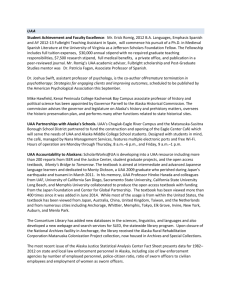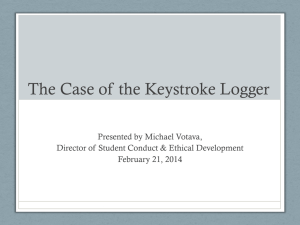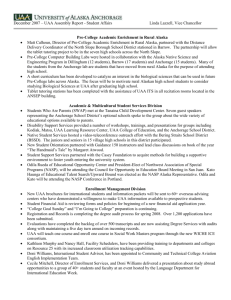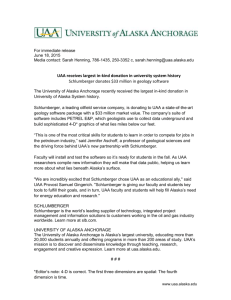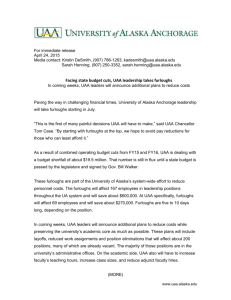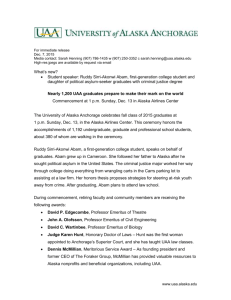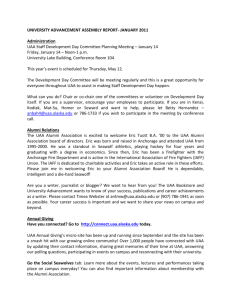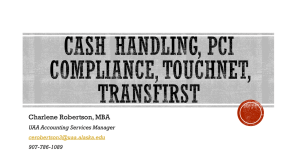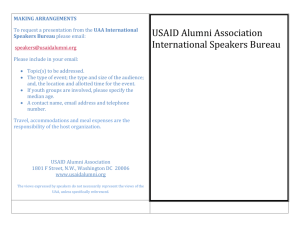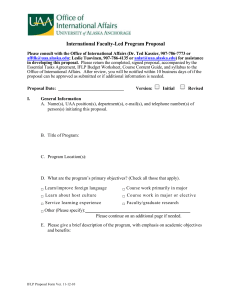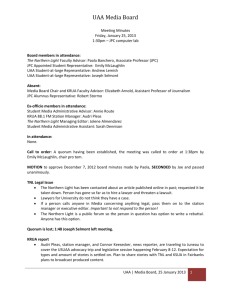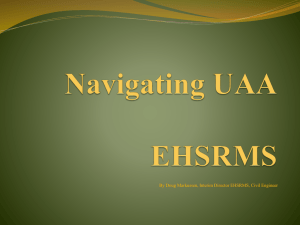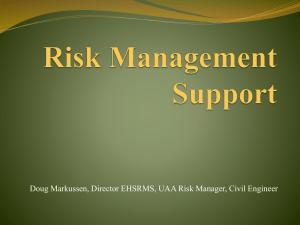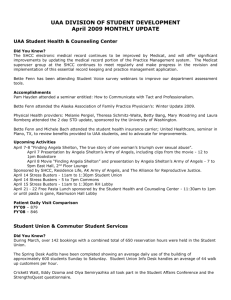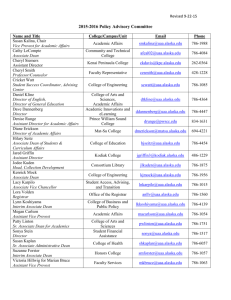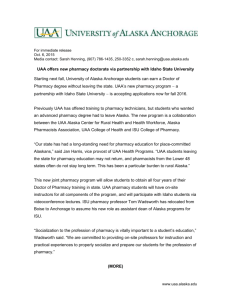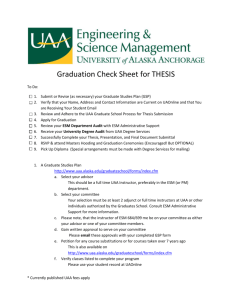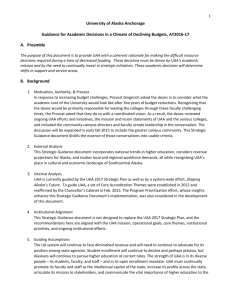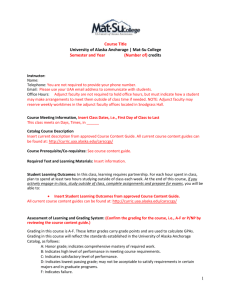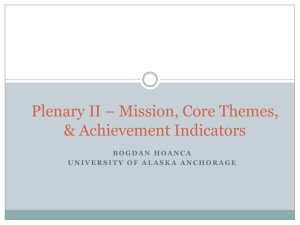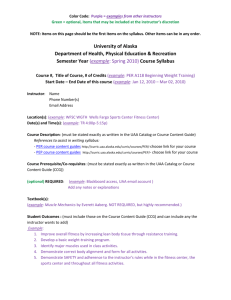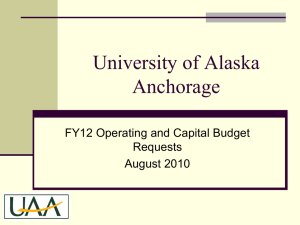UAA Care Team Presentation - University of Alaska Anchorage
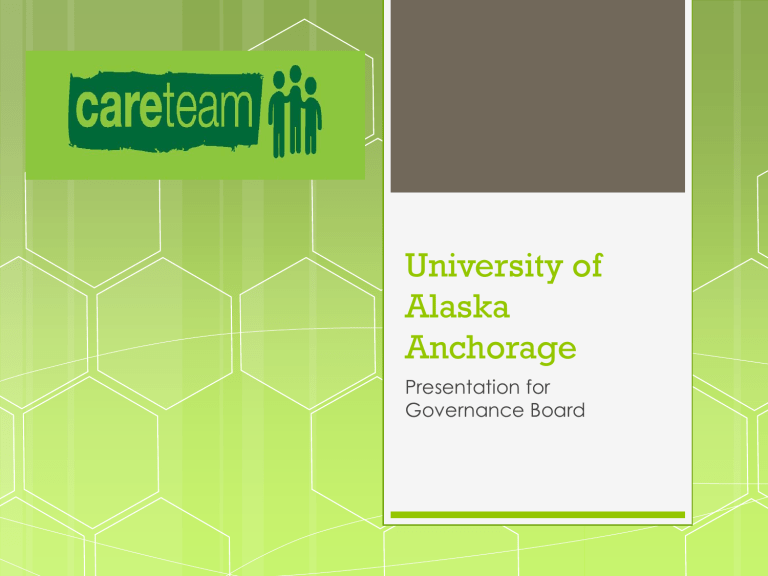
University of
Alaska
Anchorage
Presentation for
Governance Board
UAA Careteam
Part One
An Introduction:
Careteam
University of Alaska Anchorage
Behavioral Intervention Team
Dean of Students Office
University of Alaska Anchorage
UAA Careteam
Behavioral Intervention Teams
Originated as a Response to
Violence on Campus
(Chronicle of Higher Education, 2007) o Since 1966, there have been 88 shooting deaths at various
U.S. universities and college campuses o In 2000 the National Center for Higher Education Risk
Management was founded (NCHERM) o In 2009 the National Association for Behavioral
Intervention Teams Association was formed o In 2010 UAA started formalizing the foundation for a
Behavior intervention team—Using the Best Practice in the Field
Elements of BIT Best Practices
• Focus on student-based risks, as well as faculty and staff
• Integration with campus risk management programs and risk mitigation strategies
• Using formalized protocols of explicit engagement techniques and strategies
• Fostering a comprehensive reporting culture within the institution
• Training and educating the community identifying and reporting concerning behavior
• Comprehensive databases for longitudinal monitoring and identifying behavior patterns and trends;
• Record keeping and record management best practices
• Performing interventions and assessing for effectiveness
• Threat assessment w/in the BIT model- Using risk rubrics to classify threats
• Threat assessment tools — use, value and application
• Incorporating violence risk assessment as a team function
UAA Careteam
Careteam's Focus
• SAFETY:
Individual Care—Reach out, Offer Solutions
Community Safety—Solutions focus on the balance community needs
De-escalate situations quickly
• PREVENTION:
Address Underlying causes of concerning behavior
Catch the problem before it becomes bigger
Create a Bystander awareness vs. Big Brother Mentality
• RESPONSE/RESULTS:
Increase Reports, Increase response
Increase Response, Decrease escalating behaviors
“Carefrontation”
with lower risk cases = Prevention
“Sense Something…Say Something...Do Something”
UAA Careteam
Care Team Provides Prevention……
As One conduit through which to funnel concerns about students
Encourages Anyone to Express a concern in the Spirit of community (Student, Staff, Faculty, Family, Community members)
Intentionally cast a “wide net” (“Sense Something”)
Involves a Response Team of Representatives from major campus resources
Key idea: collaborative consultation/joint recommendations
UAA Careteam
Three of 66 + Reasons Why
Prevention is So Important
• Case Western Reserve University 2003, one person killed and 2 wounded
• Virginia Tech 2007, 33 killed
• Northern Illinois University 2008, 5 killed
• Incidents are rare, but each occurrence has a wide ranging impact
UAA Careteam
“Proactive Prevention”:
Signposts and Leakage
Many students who initiated violence toward others
“engaged in some behavior prior to the incident that cause others concern or indicated a need for help”
(Vossekuil et al, 2002, Final
Report and Findings of the Safe School Initative)
“Nonviolent people do not 'snap' … Instead [they show] signposts along the way...A threat...brooding about frustration or disappointment, fantasies of destruction or revenge, in conversations, writing, drawing and other actions.”
(www.fbi.gov/stats-services/publications/school-shooter)
“Leakage can be a cry for help, a sign of inner conflict, or boasts that may look empty but actually express a serious threat [to self or others]. Leakage is considered to be one of the most important clues that may precede [a] ...violent act.”
(www.fbi.gov/stats-services/publications/school-shooter)
Low Tolerance for Frustration -Poor Coping Skills
Lack of Resiliency --- Narcissism.
Failed Love Relationships ----“injustice Collector”--
Signs of Depression --- Lack of Empathy --- Alienation
Dehumanizes Others --- Exaggerated Sense of Entitlement
Attitude of superiority ---- Exaggerated Need for Attention ---
Externalizes Blame --- Masks Low Self-Esteem
Lack of Trust -- Anger Management Problems
Intolerance --- Inappropriate Humor Seeks to Manipulate others
Closed Social Group --- Change of Behavior
- Unusual interest in Sensational violence Fascination with
Violence-Filled Entertainment
Rigid and opinionated --- Negative Role Models
Behavior appears Relevant to Carry Out Threat
UAA Careteam
Common Student Mental Health
Issues
Depression
Anxiety
Suicide Ideation
Alcohol Abuse
Eating disorders
Self Injury www.apa.org/about/gr/education/news/2011/college-campuses.aspx)
UAA Careteam
The Careteam Meets for One Hour Each Week and makes recommendations to:
Dr. Dewain L Lee: Dean of Students
Team Members:
Dawn Dooley,
Associate Dean;
Chair of Careteam
Michael Votava,
Dir. Student Conduct &
Ethical Development
Rick Shell, Chief of Police
Georgia DeKeyser, Dir. of
Student Health &
Counseling Center
Ryan J. Henne, Director of Residence Life
Lisa Terwilliger,
Careteam Coordinator
Jessica Mason,
Counselor Liaison to the
Faculty
Sierra Mills: Student
Success Counselor
Part Two
The Process:
Careteam
Dean of Students Office
University of Alaska Anchorage
UAA Careteam
UAA Careteam
Referral Process
Begins with an Informal or Direct Written Report of concern about a particular student
Informal Care Team inquiries can be made by:
Call the following & Staff with Enter a Report
Dean of Students office, 786-1214
Careteam office, 786-6065 in PSB 119
DOS Counselor, 786-6158
Email:
Care@uaa.alaska.edu
Direct Report
UAA Careteam
Click this to submit an on-line report— that can be anonymous
UAA Careteam
Careteam Process for a Report
Results:
FY 2010:
Reports: 145
Follow Up: 219
FY 2012:
Reports: 193
Follow Up: 386
UAA Careteam
FY: 2011
Reports: 185
Follow Up: 313
FY 2013
Reports: 236
Follow Up: 504
